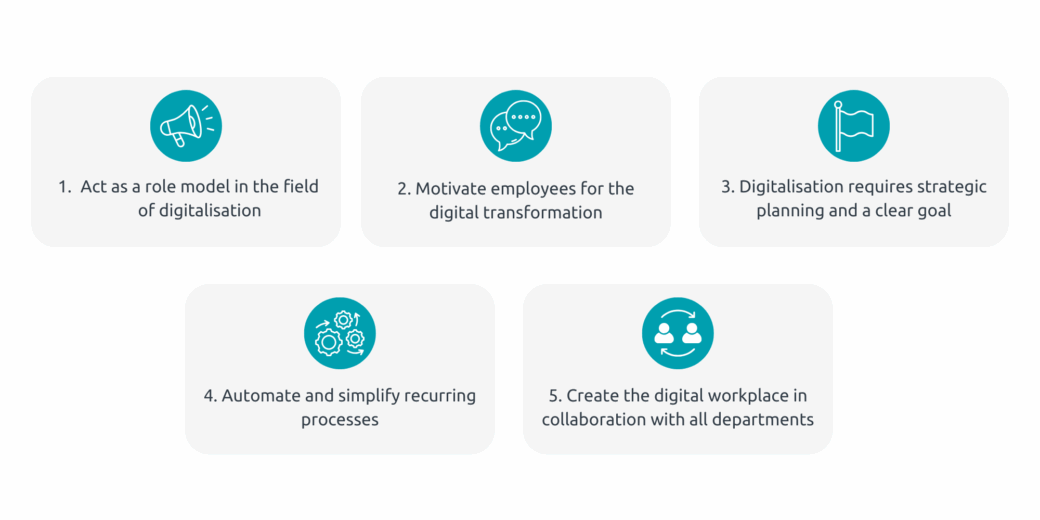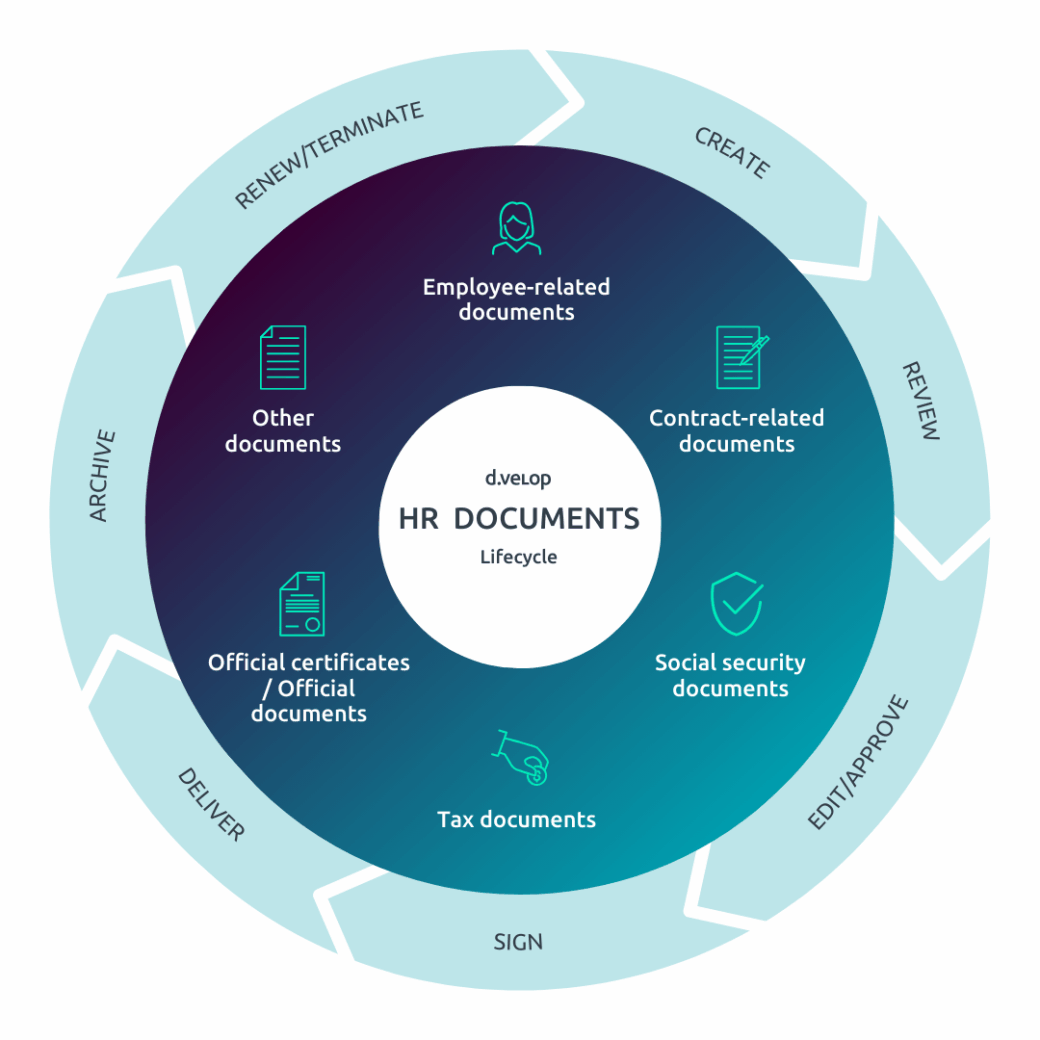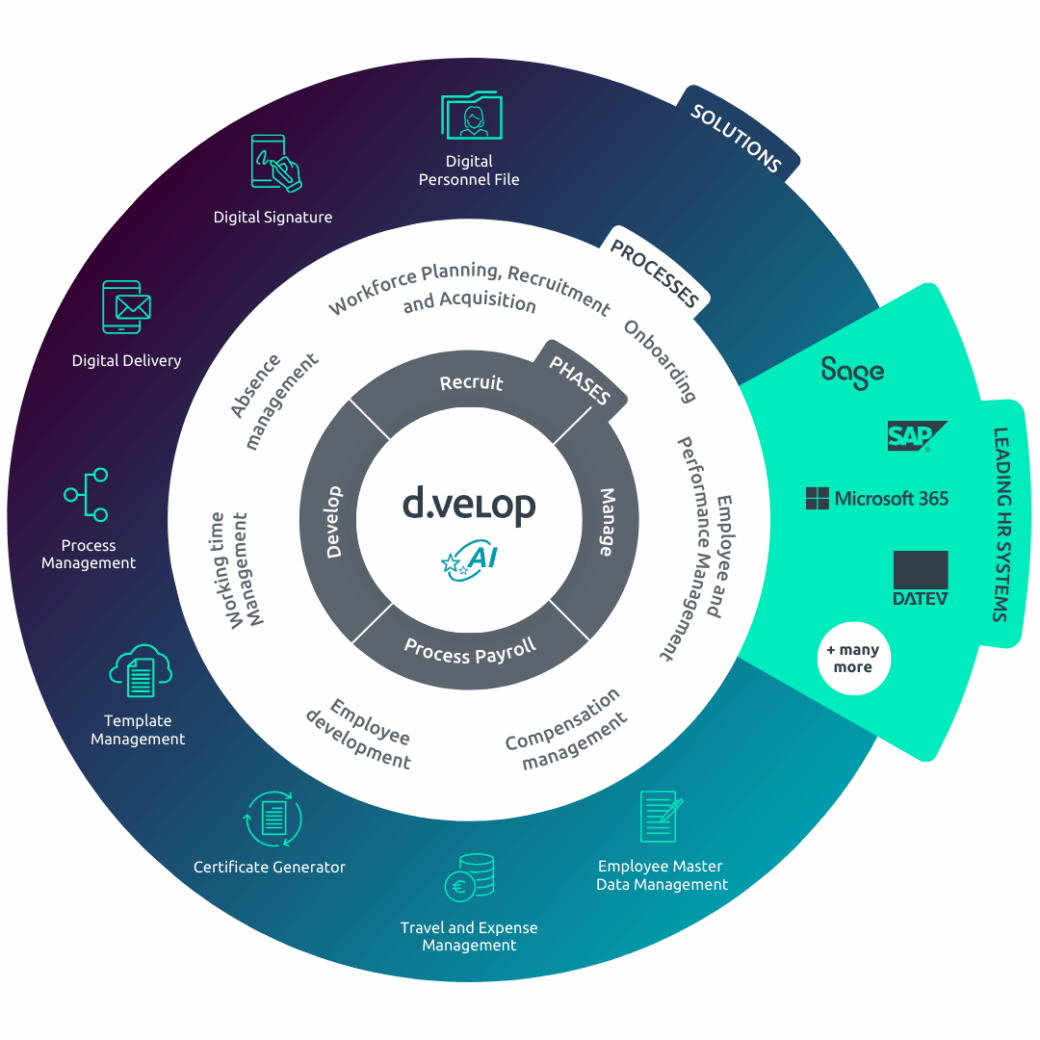Tasks and Challenges of an HR Department
Tasks
The responsibilities of HR professionals are diverse. Fundamentally, they are responsible for personnel administration, employee development, and other HR-related matters. Depending on the company, these tasks may include:
- Workforce planning or personnel requirements planning
- Recruitment and talent acquisition
- Personnel deployment planning
- HR administration or human resource management
- Payroll processing
- HR controlling or people analytics
- Strategic planning
Uitdagingen
In many smaller companies or start-ups, there is often a family-like atmosphere where everyone feels personally responsible. The main hiring criterion: the new employee fits in with the team – or doesn’t.
However, this personal touch tends to fade as the company grows. At this stage, employee satisfaction often declines, and staff turnover increases. Many tasks that previously happened naturally and informally now fall under the responsibility of HR.
With structure and process automation, fast-growing companies can overcome these challenges. HR departments deal with a large number of highly standardised documents and processes, and the information handled is often very sensitive. Yet, the potential of digitalisation in HR is often underestimated.
Benefits of a Digital HR Department
The benefits of HR digitalisation extend beyond the HR department – they support the entire organisation and every individual employee. In addition to the advantage of having 24/7 access to all documents via a document management system (DMS), even while travelling or working remotely, the following benefits arise:
- Improved process quality: Lengthy and error-prone processes can be handled more efficiently through digitalisation and automation.
- Cost reduction and time savings: Routine document-related tasks can be completed faster and more efficiently through automation.
- Increased flexibility: Digital processes allow for a more agile response to changes and new trends.
- Better decision-making: Data analysis can provide valuable insights and support well-informed HR decisions, especially in recruitment.
- More time for strategic tasks: Such as workforce planning, recruitment, and employee development.
- Higher employee satisfaction and retention: Employees can be reached more easily, contributing to a positive work environment and stronger loyalty to the company.
In addition, younger employees tend to be highly flexible and, due to their values, are more likely to resign when dissatisfied. Creating a modern working environment can help counteract this trend. Employees expect companies – and therefore HR – to offer greater transparency, flexibility, autonomy, and a values-driven corporate culture.
More Time for Value-Adding Tasks
One major issue in HR departments is the high administrative workload. Administrative tasks such as document management and data maintenance account for 37% of HR professionals’ working time.
At the same time, employees are calling for more time to focus on strategic tasks, such as:
- Enhancing the employee experience
- Employee development
- Recruiting new talent
As shown in the PWC study People Management 2025, these tasks will become increasingly important in the coming years. To ensure sufficient time for value-adding activities, digitalising the HR department is a key factor. With a digital personnel file, all information is stored centrally, and automating various tasks saves HR professionals a significant amount of time.
Digitalising the HR department not only helps HR professionals focus on strategic tasks – it also improves the overall employee experience. A better experience leads to higher employee satisfaction. And satisfied employees are more engaged, which in turn drives a positive upward trend with long-term benefits for productivity.
The HR Department as a Pioneer
The HR department should be seen as a core area with a role model function – one of the digitalisation pioneers within the company. HR professionals can help foster a pro-digitalisation mindset. It’s important that they approach the topic strategically and have a clear vision of what digitalisation should look like. Automating recurring processes, such as sending out payslips, is just the beginning. Applicant management, workforce planning, collaboration scenarios – the digital workplace and the HR of the future offer many opportunities. However, HR can only achieve this in collaboration with all departments.

Digitalising HR Processes
The foundation lies in the digitalisation of HR processes and services. This makes all HR management activities – especially tasks like analysis and controlling – significantly easier.
What Are HR Processes?
Before we can explore how your HR department can benefit from digitalisation, we first need to clarify: what exactly are HR processes? HR processes are complex activities within the HR department that contribute to a company’s success. On the one hand, they support smooth operations through administrative functions. On the other hand, they influence the quality of work across the organisation through technology-supported strategic workforce planning – including the selection and development of employees – and they impact the efficiency of workflows. Almost all of these processes involve documents.

Automating Time-Consuming Processes First
Digital transformation primarily focuses on automating repetitive workflows – tasks that are especially time-consuming. Payroll processing is a prime example. Suitable software can carry out payroll calculations accurately and efficiently, generating payslips automatically. It can even detect errors in employee data and report them – all without manual intervention.
- 45 % reduction in time to hire through digitalisation.
- 52 % of working time is spent on routine tasks.
- 65 % of HR professionals’ time is spent on document processing.
Areas in HR with a Need for Digitalisation:
- Recruitment
- Workforce Planning
- HR Management
- Compensation and Benefits
- Training, Development and Career Planning
- Travel Expense Management
From Automated Travel Expense Reports to Infinity
Discover the d.velop process studio – your opportunity to revolutionise all HR workflows. This innovative solution allows you to easily visualise, analyse, and optimise complex processes. Its intuitive design ensures seamless integration into your HR systems, offering automated workflows and real-time analytics. Boost your HR team’s efficiency, reduce costs, and improve collaboration across the organisation – for example, with automated travel expense reports or smart procurement requests. Your possibilities are endless, and the benefits are clear: more transparency, less paperwork, shorter processing times, and cost savings. Invest in employee satisfaction and simplify your HR processes with the d.velop process studio.
The Digital Personnel File
The digital personnel file digitalises and automates HR processes, providing greater transparency. It manages all employee documents and speeds up HR workflows.
Digital Payslips
Delivering payslips on paper is not only costly – preparing and sending them is also time-consuming. With d.velop postbox, payslips can be delivered digitally with ease. This saves valuable time and relieves employees through efficient processes, allowing more time for what really matters in the workday.

Wit papier
Digital payslip delivery
Organisations today have a better option: They can choose digital delivery for payslips and salary statements to optimise their processes and harness potential while saving time and money.
The solution is the digital postbox. Read on to learn the key requirements, functions, and advantages of digital mail delivery. Once set up, you’ll soon see how the digital mailbox offers many benefits besides just cost and time savings.
The aim of this white paper is to present the optimal solution for your digital payroll delivery and guide you through the steps to implement this in your company.
Reducing Time-to-Hire with Digital Signatures
Potential candidates often drop out during the recruitment process. One key reason is a long time-to-hire – the period HR professionals need to hire selected candidates. It begins with the application and ends when the position is filled.
Time-to-hire reflects the length of the hiring process from the candidate’s perspective.
44% of recruiters already use this metric to optimise their recruitment process.
There are two types of costs associated with time-to-hire:
- Direct costs, primarily recruitment expenses
- Indirect costs, especially opportunity costs due to unfilled positions
Ways to Optimise Time-to-Hire:
Review the Recruitment Process
Examine each step and assess what’s truly necessary.
Candidate Experience
The perception of the process starts on the careers page. Clear communication with candidates is essential – explain each step and what comes next.
Internal Communication
Lengthy internal communication and complex coordination across departments increase time-to-hire. Recruitment tools and software can simplify this.
Active Sourcing
Instead of waiting for candidates to apply, actively search for talent using platforms like Xing, LinkedIn, or career fairs.
Employer Branding
Clearly communicate your company culture, work environment, and unique selling points. The more attractive these are, the faster you’ll find suitable candidates – reducing time-to-hire.
Digitale handtekening
Sending contracts by post, waiting for signatures, and returning documents takes time. With electronic signature software, this process is significantly faster, saving costs and protecting the environment.
By using tools like d.velop sign, d.velop was able to reduce time-to-hire by more than 40%.

Holistic Digitalisation
Helpful d.velop Products for Your HR Department at a Glance
Embrace holistic digitalisation. This way, manual processes that cost your team valuable time become a thing of the past – across the entire organisation.
- Reference Letter Generator
- Travel & Expense Management
- 500+ Integrations
The Path to a Digital HR Department
d.velop’s customers are reaping significant benefits from their progress in digitalisation. A key component of this transformation is digital transformation itself – a continuous process of technological advancement within organisations.
HR must evolve, become more digital, and adopt a digital mindset. Most importantly, it must embrace technologies that fundamentally reshape the HR function. Modern HR uses digital tools to work more strategically.
What Is HR Transformation?
The term “HR transformation” refers to a digital change process within human resources. It begins in the HR department and gradually extends to all areas of the organisation. HR leads by example, setting the standard for what should become the norm across the entire company. In this way, HR becomes the driving force behind a large-scale change within the workforce.
How to Successfully Achieve HR Transformation in 12 Steps
1. Initiate the Digital Shift
Recognise the need for change and inform your workforce about the pain points.
2. Prepare Your HR Team for Digital Technologies
Assess the current state of your HR department. Do you need external support to train your team for a digital future?
3. Develop a Clear Digital HR Strategy
Gather reliable data to design a strategy. This will help identify bottlenecks and uncover potential within the organisation.
4. Inspire a Willingness to Change
All HR team members must be on board for the project to succeed. Highlight the benefits and future improvements to gain their support.
5. Redefine Roles Within the HR Organisation
Question rigid and outdated HR structures and workflows. Adjust roles and responsibilities accordingly.
6. Build Digital Expertise Within the Company
Develop your workforce for modern, digital ways of working. Use internal know-how or bring in external experts. Involve curious, adaptable team members who are eager for change.
7. Prioritise HR-Relevant Technologies
Don’t overhaul all analogue workflows at once. Take a holistic approach to HR technologies, introduce them step by step, and build on each implementation.
8. Clarify Legal Aspects of Digital Technologies
Data protection is key. For example, GDPR and GoBD do not permit sensitive data to be stored on servers outside the EU.
9. Create a Digital Environment: The Digital Workplace
The digital workplace brings together digital workflows and digital workspaces.
10. Leverage Human Capital Analysis (HCA)
HCA aims to help employees use their talents and skills to achieve company goals. Use analytics tools to gather HR data and relate it to data from other departments.
11. Establish Agile Working Methods
Agile methods allow teams and processes to adapt quickly to change. Agility helps respond to crises and shift direction efficiently.
12. Apply and Optimise Technologies
Implement new technologies and foster a culture where digital thinking and action are the norm. Choose HR and other software that integrates with existing systems – for example, SAP HCM or SAP SuccessFactors. Ensure seamless processes that replace time-consuming manual tasks.

white paper
Digitale personeelsdossiers en HR-processen. De innovatieve software voor toekomstbestendige processen in personeelszaken
Deze functionele uitbreiding groepeert uw personeelsdocumenten in een hiërarchische mappenstructuur voor een duidelijke en georganiseerde weergave in de SAP GUI. En met de Fiori add-on wordt niet alleen de gebruikersinterface weergegeven in het SAP Fiori-design, u kunt ook een autorisatieconcept configureren om werknemersspecifieke toegang tot bepaalde documenten te verlenen.
Wat kunt u verwachten?
- HR-processen optimaliseren voor de toekomst
- Voorproefje van SAP SuccessFactors
- Ideale integratie met SAP ERP
- Autorisatieconcept met Fiori Launchpad of SAP GUI
- Optionele extensies voor bestandsopslag
- Auditbestendige opslag van alle soorten documenten en elektronische bestanden
Digital HR Department on the Blog
Learn more about HR digitalisation
On the d.velop blog, you’ll regularly find insights, inspiration, and expert articles on the digital HR department, legal aspects, current market developments, and much more.
Frequently Asked Questions About HR Digitalisation
The benefits of HR digitalisation include time savings through the automation of routine tasks, cost reductions through process optimisation, improved data management, greater transparency, and efficient document archiving.
HR processes are complex activities within the HR department that contribute to a company’s success. On the one hand, they support smooth business operations through administrative functions. On the other hand, they influence the quality of work across the organisation through technology-supported strategic workforce planning and improve workflow efficiency.
HR processes include recruitment, workforce planning, and HR management, as well as compensation and benefits, training and development, and travel expense management.
HR transformation refers to the digital change process within human resources. It begins in the HR department and gradually extends to all departments of a company.
Contact & Consultation
We Connect Data and People – And Look Forward to Hearing from You.
Curious? We’d be happy to show you our software.
Simply request a live demo.



